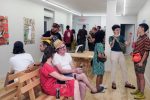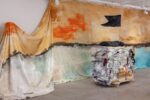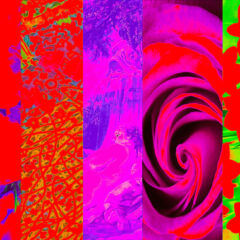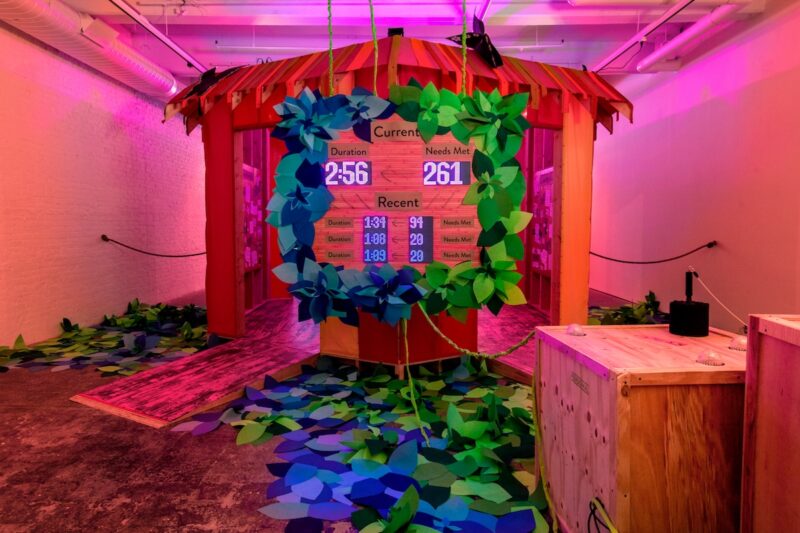
Risa Puno’s first solo museum exhibition, Group Hug, filled me with immediate childlike wonder. I had been energized to experience this exhibition at the Fabric Workshop and Museum, and it not only delivered in terms of visual, material, sonic and haptic sensations, but also in its clear message. In Group Hug, Risa Puno playfully approaches topics that are seminal to human nature and needs: community, well-being, cultural heritage, and the complex and often invisible labor of caring for one another.
Puno’s personal and familial backgrounds in art and medicine fuse with her multicultural Philippine identity to create not only a whimsical multicolor soft-sculpture installation, but an interactive game. Unlike exhibitions that feature several individual works displayed throughout a gallery, Group Hug is one cohesive experience: a ‘choose your own adventure’ in which each visitor is met with two deviating paths of ‘Care For’ and ‘Cared For.’ The Cared For enters the show through labyrinthine curtains, arriving to electronic soft-sculpture ‘pods,’ in which they are meant to recline and rest. The Care For participant is given an initial preview of their eventual interactive game comprised of colorful orbs–‘Needs to be Met’–that must be hit with a mallet–‘Tool for Caring’–all carefully incorporated into a hard-sculpture console station. The game’s focal point is a scoreboard indicating ‘Time Elapsed’ and ‘Needs Met,’ where each orb successfully struck results in a point that prolongs the length of the Cared For’s time in the pod. Seemingly simple in concept, the game provides levels of difficulty through the limited reach of an individual Tool for Caring and increasing frequency of Needs to be Met. The metaphor for the act of caring is clear: the game must be played simultaneously in groups to ensure greater success for those requiring convalescence, and shared labor and consistent reciprocity ensure that resources for caring are always abundant. I highly recommend experiencing Group Hug with close friends and family of all ages, as it is also child-inclusive.
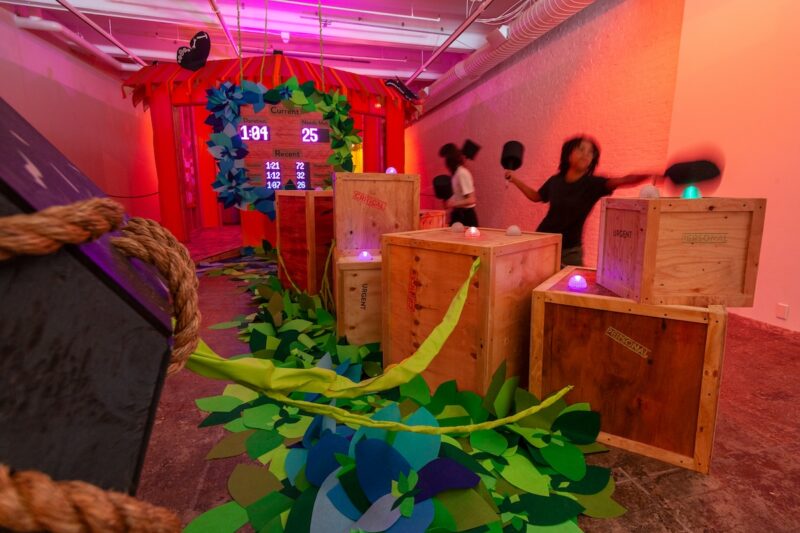
Once the first caring experience ends, visitors are invited into a central stilt-house structure vernacular to and iconic of the Philippines, called “bahay kubo,” containing an interactive game comprised of one giant soft-vinyl 20-sided die. This area invites players to consider difficult questions surrounding their relationships to caring. Behind each player, the bahay kubo walls display two identical project boards, containing Puno’s own hand-written notes, family photographs and anecdotes, process drawings, and clippings that influenced Group Hug. Seldom do we have the privilege of viewing the artist’s process in a museum exhibit, and this transparency is successful in conveying the immense labor behind and salient motifs within the show. I personally delighted at the crossword puzzle clue after which the exhibition is named: ‘Many-person act of support or affection.’ Each word in this clue is essential to the experience of caring, and therefore to the exhibition. Beyond the bahay kubo, the game commences again with roles reversed: the carer becomes the cared-for and vice versa, as often occurs in our daily lives.
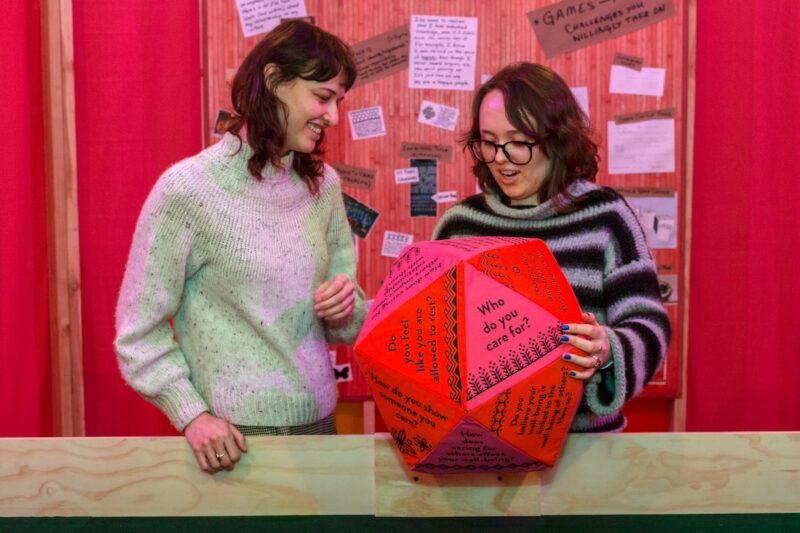
Given the cohesiveness and holistic nature of Puno’s Group Hug, I wish to note the key components of the interactive sculptures and layout: sound and lighting are seminal in the show, with recordings from nature and gentle voiceovers meant to soothe the cared-for as they recline in the pods. Sound is also utilized to stimulate the carer within the whack-a-mole-style game and incentivize their caregiving success. Lighting interplays with sound, where the warm-colored low ambient glow of the gallery contrasts with the flashing greens, purples, yellows and reds of the orbs. Finally, as the game begins for each visitor, a recorded voice greets with “Mabuhay!”–meaning “to live” in Tagalog–which further cements this show within the Philippine cultural identity of sharing and mutual care for prolonged life.
The sculptural components and built environment are the centerpoints of the show, with felted leaves strewn along the floor and walls, referencing tropical plant species. The pods contain soft stuffed fabric leaves carefully quilted together to further perpetuate the cared-for’s soothing experience. Opposite the pods, the gaming station is comprised of unfinished wooden boxes made to resemble shipping crates, with words ‘Critical’ ‘Urgent’ and ‘Personal’ painted on. The references to migration, exchange of materials, and the cruciality of caring are simple and clear.
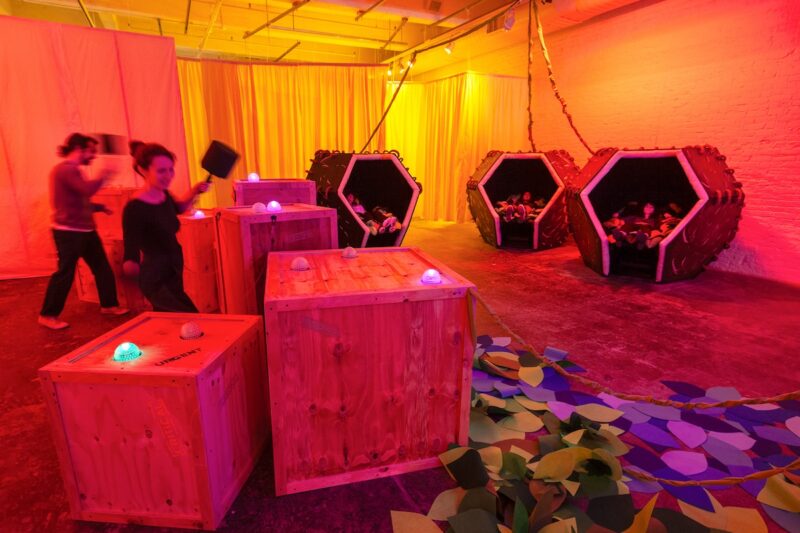
Finally, as an assistive technology maker and advocate, I am most moved by the electronic component of the pods. These are made from Electric Lift Chairs that both recline fully and assist people with disabilities or elderly folks with standing fully erect. The incorporation of assistive technology in this exhibition is particularly salient for me because it speaks to our shared human experience: either we are disabled when we are young–myself included–or we eventually become disabled with old age. Assistive technology and accessible spaces help ensure inclusivity for all aspects of our lives.
We know from Group Hug – and many of us from experience – that caring is active and cannot be done alone; fewer needs are met with fewer resources, and the immense labor of caring for others can only be successful in numbers. Risa Puno’s show signals this powerful message about community and reciprocal care, with both her personal familial connection and with optimism for how we could work better together in societies globally, from North America to the Philippines and beyond. The overall joy and warmth of Risa Puno’s Group Hug will certainly create positive and meaningful impact in this ongoing time of crisis.
Risa Puno: Group Hug, until July 21, 2024. Fabric Workshop and Museum


